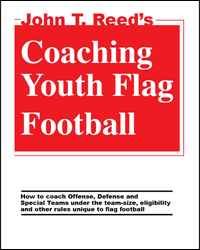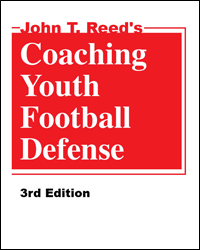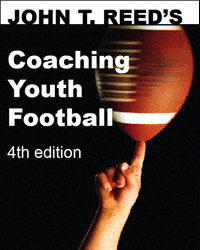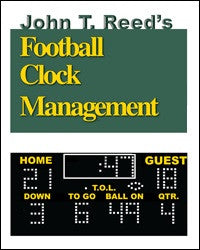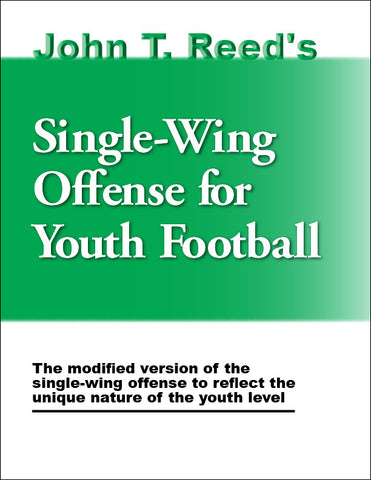
Single-Wing Offense for Youth Football
I continue to receive, and post on my Web site, emails from coaches thanking me for the offense and telling me of their team’s success with it. The single-wing offense has produced great success for many coaches, including winning a California high school state championship and was used in several forms in the NFL by at least 9 different teams, most notably the Miami Dolphins ("Wildcat" formation). 154 pages, 8 1/2 x 11 paperback, $29.95
- Reader comments
- Table of contents
- Turbo charge any offense with the
- warp-speed, no-huddle tempo
- Changes to the book
- Index
- Front matter (copyright page, etc.)
- Corrections and supplemental material
Since we put it in some 6 years ago, we have never had a losing season, been to the CIF–SS play-offs every year, and to the Championship game twice. (2003, 2008) and, as I say, just won the ring! The year before we put this offense in we went 0-9, THEN….. 5-5, 11-2, 9-3, so on and so forth until this year winning it all. - Jon Stone
Miami Dolphins' Wildcat formation brings the Single-Wing offense back to the NFL
At least 9 different NFL teams have used the "Wildcat" formation (the Dolphin's name for the single-wing offense), recently popularized by the Miami Dolphins upsetting the New England Patriots in Week 3 of the 2008 season. Ronnie Brown rushed for 4 touchdowns and threw a 5th touchdown in the 38-13 upset. They only called the formation 6 times.
Once the dominant offense in football
The single-wing offense, although currently out of fashion with high school and higher level coaches is one of the soundest, most proven offense in football. It was invented by Pop Warner, who was the winningest college coach of all time until just recently. From its invention in 1912 until some time after the advent of the T-formation in 1940, the single wing was the dominant offense in football. Tom Harmon, the Heisman Trophy winner from Michigan in 1940 was a single-wing tailback. Almost all college national championships and NFL championships in that period were won by single-wing teams.
The T-formation worked well back then mainly because the defenses were all geared up to stop the single wing. Now, the exact opposite is true. The defenses are geared up to stop the T-formation. Today, the typical offense at the youth and high school levels is a pro set I (tight end and flanker on one side; split end on the other; fullback and tailback in the backfield). In response, the typical defense is a 5-2-3 with a strong safety as a third linebacker on the strong side of the offensive formation. That is a very poor defense for stopping the single wing, which is why most of my readers have been kicking butt with the single wing around the U.S. and Canada. See the reader comments for my book Coaching Youth Football.
Single-Wing Offense for Youth Football uses an unbalanced line single wing with a flanker. Youth defense often fail to adjust to the unbalance line. The single wing is a great offense for passing—indeed, the currently popular shotgun formation is a slightly modified version of the single wing. Single-Wing Offense for Youth Football has twelve plays total, seven of which are passes or run-pass options.
But the single wing is even better for running, which is the forte of youth-football players. Run this offense and you will probably have both the most powerful and the most deceptive plays in the league. The power plays work because you greatly outnumber the defense at the point of attack. The deceptive plays work because the defense has to “cheat” to stop the power plays, thereby weakening themselves in areas that you attack with misdirection plays. Also, the placement of the backs enables greater deception than the placement of T-formation backs. Single-wing coaches report officials blowing plays dead because they were completely fooled by a fake, linebackers shedding the ball carrier thinking he is a blocker, and cameramen following the wrong guy for thirty yards down the field.
Heck, opposing coaches and public address announcers don’t even know what to call it, let alone how to stop it. They think it’s a shotgun. They fail to understand the basic concept of outnumbering them at the point of attack. They try to stop the offense with a T-formation defense with players scattered all over the field while the single-wing coach masses his forces at the point of attack. Their linebackers try to read the play too quickly which is suicide against the single wing.
Passing is extremely difficult for youth teams, but Single-Wing Offense for Youth Football chooses its pass plays very carefully and goes to great lengths to explain how to install and practice them. The book features many short-flight-distance passes like the sprint-out, hook, hitch, and one long pass: the deep post. These passes are employed only on a keep-the-defense-honest basis. That is, as long as the defense hangs back in the usual 5-3-3 with defenders scattered all over creation, the offense pounds away with its massed ground forces. But if the defense dares to crowd the line of scrimmage like the single-wing offense does, we can pop several short passes and one long pass behind them.
Single-Wing offense for Youth Football is a 118-page, 8 1/2 x 11, combound book. It provides an extremely detailed description of how to staff, install, practice, call plays for, and troubleshoot a youth version of the single-wing offense. It may be the most detailed offense book ever written for any level of football.
Youth football is also known by some as Pop Warner football or pee wee football or junior football. John T. Reed has never been affiliated with Pop Warner.
Here are my two other books on tackle football offense:
When you buy 2 books at the same time, you save $2.55 on shipping to U.S. addresses. Shipping is free if you buy 3 or more books at the same time.
We Also Recommend




